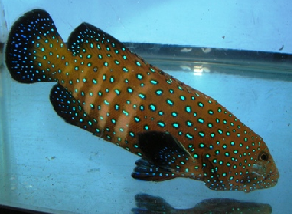 Hey, if you are planning to set up your dream marine tank… a gorgeous, large one, I have a fish for you! If you have a tank already, and facing certain odds that go with it, you might want to change the set up and the fishes. I’ll be talking about a beautiful fish - Blue Dot Grouper that you can try out. If you are thinking that you might be at a loss as to how to stock it, believe me it’s not a rocket science! With its real knockout glamor the Blue Dot Grouper will definitely fill the bill! The most common dilemma that most of the not-so-expert aquarists usually face regarding stocking Blue Dot Grouper is the size of tank! Remember, Blue Dot Grouper is really a large variety of fish and requires a large tank – minimum 100 gallon.
Hey, if you are planning to set up your dream marine tank… a gorgeous, large one, I have a fish for you! If you have a tank already, and facing certain odds that go with it, you might want to change the set up and the fishes. I’ll be talking about a beautiful fish - Blue Dot Grouper that you can try out. If you are thinking that you might be at a loss as to how to stock it, believe me it’s not a rocket science! With its real knockout glamor the Blue Dot Grouper will definitely fill the bill! The most common dilemma that most of the not-so-expert aquarists usually face regarding stocking Blue Dot Grouper is the size of tank! Remember, Blue Dot Grouper is really a large variety of fish and requires a large tank – minimum 100 gallon.Also called Blue-spotted Grouper, Argus Grouper, Peacock Rockcod , Peacock Sea Bass or Peacock Hind, this beautiful marine aquarium fish is of Indo-Pacific and Hawaii origin and amongst the sturdy ornamental fishes that have earned a great deal of admiration by aquarists world wide. Being a sea bass from the family Serranidae, the Blue Dot Grouper primarily feeds on other small fishes in the wild, though it can be fed on crustaceans (krill, small fish, shrimp, mussels etc.) too in your aquarium. Feed at least two times a day with its preferred meaty food items. Remember, this most attractive member of the genus is a bit too aggressive by nature and its compatibility must be give careful consideration. Only one Blue Dot Grouper fish should be kept in a tank. Although this beautiful marine fish may appear a bit shy while introducing, it will soon prove to be one of the most beautiful, smart, disease resistant and personable member of your marine aquarium.
One of the most interesting facts about this wonderful marine fish is that it can change its body color to match with its surroundings. In its natural habitat, Blue Dot Grouper fish is usually seen around the coral reefs. Blue Dot Grouper fish has six white vertical stripes or bands, running along the length from the pectoral fin till the tail fin, adding spice to its beauty. Interestingly these white bands sometimes becomes prominent, while sometimes get faded off being contingent upon the fish’s surrounding environment and its reaction towards it. When threatened these vertical white bands seems to be faded off.
Blue Dot Grouper – Fast Facts
- Scientific names: Cephalopholis argus
- Origin: Indo-Pacific region.
- Taxonomy: Blue Dot Grouper fish belongs to the Kingdom Animalia, Phylum Chordata, Class Actinopterygii, Order Perciformes, Family Serranidae, Genus Cephalopholis and Species argus
- Fish Size: Approximately 16 inches on maturity.
- Tank Size: Minimum 100 gallon fish-only tank with ample space to move freely
- Color: Blue, Brown, Tan and Green colors with vibrant blue spots. The fins are dark Blue in color with its lighter, yet prominent shade outlining the fins.
- Aggression: Generally aggressive towards the other marine aquarium invertebrates in captivity.
- Compatibility: Blue Dot Grouper fish is moderately reef compatible. This aggressive marine fish can be kept with other aggressive and semi-aggressive tank mates like, Lionfish, Angelfish, Scorpion Fish, Marine Eels, Surgeons and Tangs.
- Light: Blue Dot Grouper appreciates moderately low illumination in the marine aquarium.
- Temperature of water: Water temperature should range between 72 to 78 degrees Fahrenheit.
- Specific gravity of water: 1.023 to 1.025.
- pH of water: 8.10 to 8.40.
• Blue Dot Grouper is a large fishes and develops habit to dislodge the corals in your marine aquarium. It is hence advisable not to keep it in a Reef Type Marine Aquarium.
• Due to its large size and voluminous eater, Blue Dot Grouper usually leaves around lot of waste in the marine aquarium. You should be highly vigilant to keep your tank’s water perfectly clean by using very effective biological filter.








i have a blue spotted grouper it is 30 years old how long does it live dbelardo1@verizon.net
ReplyDelete